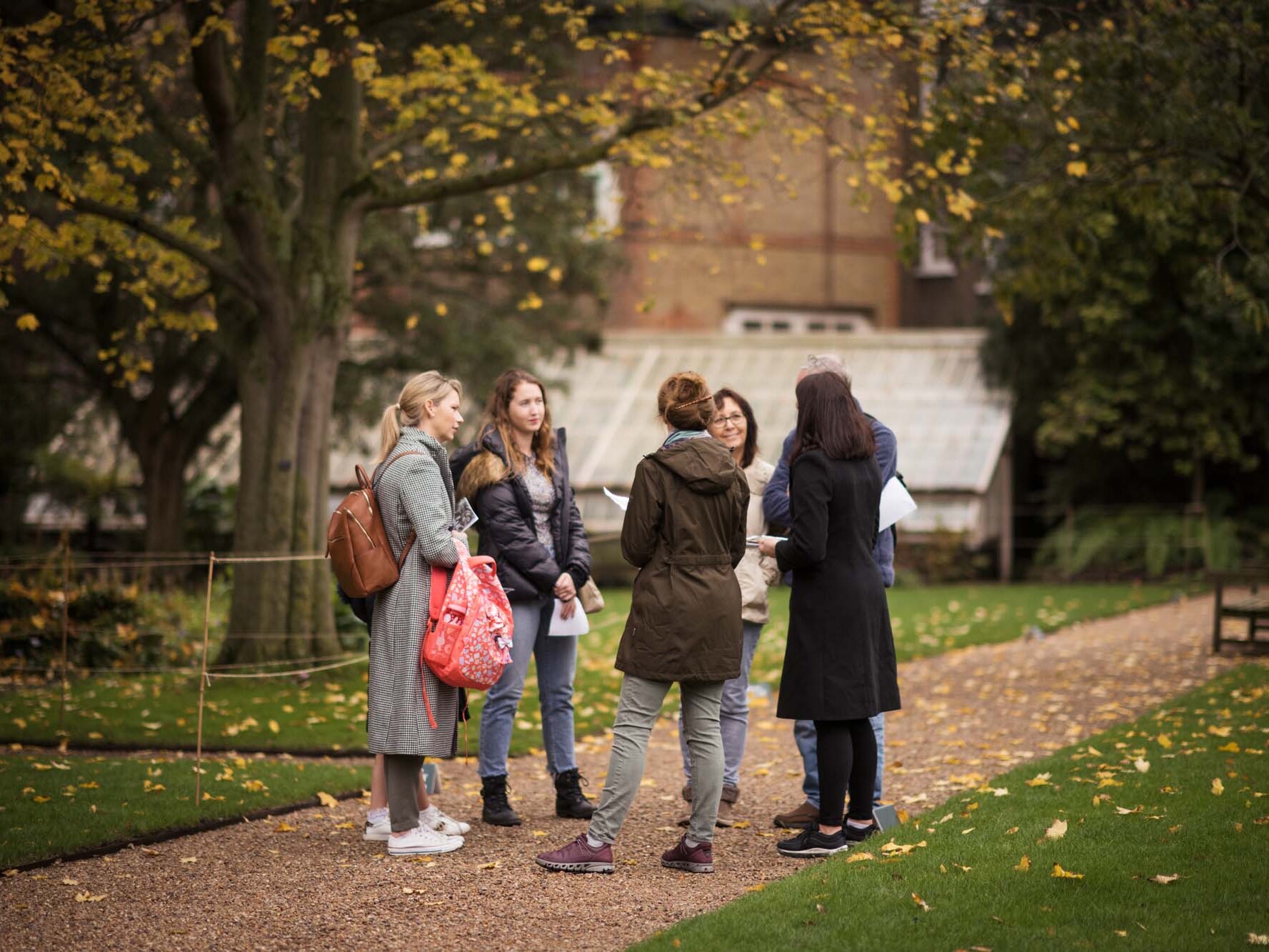Accessibility
We aim to be accessible to all and to help you plan your visit, you can find information below.
Getting around the garden
The paths around the Garden are flat and laid with small stone shingle.
We have a limited number of wheelchairs available to borrow, please speak to a staff member at the kiosk or on Royal Hospital Road upon arrival for assistance.
The Garden is on one level once inside; ramp access is available to our education space and to the Physic Garden Café. Our Gallery space, used for events and talks is up a flight of stairs without lift access. Please contact us ahead of attending a talk or event here, so we can best advise on alternatives.
Wheelchair-accessible toilets are available in the main building as well as the Physic Garden Café. Baby-changing facilities can also be found in the café.
Guide and assistance dogs are welcome in the Garden.
If you need help planning your visit to the garden, talk to us about access by calling 020 7352 5646 or email at
Accessible parking
There is one accessible parking space outside the garden on Royal Hospital Road. Metered parking is available in the roads surrounding the Garden, please look here for up-to-date rates and hours.
Directions to the Garden
We are approximately a 15 minute walk from both South Kensington Station (District, Circle and Piccadilly Lines) and Sloane Square Station (District and Circle Lines). The 170 Bus from Victoria also stops by the Garden on Royal Hospital Road, which is just a few metres away from our visitor entrance at 66 Royal Hospital Road.
If you would liked more detailed description of how to gain access to the Garden, please contact us or visit our ‘How to find us‘ page.
Luggage
We do not have a cloakroom or bag-storage facilities; due to this and for security reasons we cannot accept/store luggage for visitors. Visitors are welcome to take their luggage around the Garden with them.
Online accessibility
We are committed to providing a website that is accessible to the widest possible audience, regardless of technology or ability.
We are actively working to increase the accessibility and usability of our website and in doing so adhere to many of the available standards and guidelines.
This website endeavours to conform to level Double-A of the World Wide Web Consortium W3C Web Content Accessibility Guidelines 2.0.
These guidelines explain how to make web content more accessible for people with disabilities. Conformance with these guidelines will help make the web more user friendly for all people.
This site has been built using code compliant with W3C standards for HTML and CSS. The site displays correctly in current browsers and using standards compliant HTML/CSS code means any future browsers will also display it correctly.
Whilst we strive to adhere to the accepted guidelines and standards for accessibility and usability, it is not always possible to do so in all areas of the website.
We are continually seeking out solutions that will bring all areas of the site up to the same level of overall web accessibility. In the meantime should you experience any difficulty in accessing our website, please don’t hesitate to Contact us.
Where possible use an up-to-date browser. By using an up-to-date browser (the program you use to access the internet) you will have access to a much richer set of options to aid you as you navigate your way around this site.
The standard browsers we would recommend are below with links to install each of them:
Once installed, each will bring its own selection of accessibility options and may allow further options via the use of plug-ins. For more details see the Accessibility page for each one:
Keyboard Short Cuts / Access Keys
Different browsers use different keystrokes to activate access key shortcuts, as shown below:
| OS | Browser | Page | Shortcut |
| Windows | Firefox or Chrome | Home | Shift + Alt + 1 |
| Skip navigation menu | Shift + Alt + 2 | ||
| Internet Explorer or Edge | Home | Alt + 1 | |
| Skip navigation menu | Alt + 2 | ||
| NOTE: For Internet Explorer you will need to press Enter after using the shortcut | |||
| Safari | Home | Ctrl + Alt + 1 | |
| Skip navigation menu | Ctrl + Alt + 2 | ||
| MacOS | Safari | Home | Command + Alt + 1 |
| Skip navigation menu | Command + Alt + 2 | ||
| Firefox or Chrome | Home | Command + Shift + 1 | |
| Skip navigation menu | Command + Shift + 2 |
Options in your browser
Most modern browsers all share the most common accessibility tools, here is a list of useful features:
Incremental Search
Incremental search allows you to progressively search a web page for a particular word or phrase on a page. To enable this on your browser, press and hold Ctrl/Command and then tap F. This will open a box to type your search into. As you type, the matches will be highlighted on the page for you.
Spatial Navigation
Hitting tab will jump you to each of the items you can interact with on any page. Holding the SHIFT key and then pressing tab will take you to the previous item.
Caret Navigation (Internet Explorer and Firefox only)
Instead of using a mouse to select text and move around within a webpage, you can use standard navigation keys on your keyboard: Home, End, Page Up, Page Down & the arrow keys. This feature is named after the caret, or cursor, that appears when you edit a document.
To turn this feature on, press the F7 key at the top of your keyboard and choose whether to enable the caret on the tab you are viewing or all your tabs.
Space bar
Pressing the space bar on a web page will move the page you are viewing down to the next visible part of the page.
Text fonts
Depending on your browser, you can override all fonts on the site to one that is easier for you to read. Options can be found in your browser’s settings/preferences.
- Change Font in Firefox
- Change Font in Chrome
- Change Font in Safari
- Change Font in Internet Explorer
- Change Font in Edge
Enlarge your view
You can activate the browser zoom via these keyboard shortcuts
Options on your computer
To zoom your entire computer screen
Apple Mac and Windows operating system both contain options to enlarge your view of your screen:
Make your computer read the site aloud
This website has been built with screen readers in mind. Menus, pictures and inputs will have the correct tags and mark up to compliment your chosen screen reader.
We have tested with following tools:
NVDA (NonVisual Desktop Access) is a free screen reader for computers running on the Windows operating system. The latest version can be downloaded for FREE here (on this page you may be asked for a voluntary donation, if you do not wish to donate, click “skip donation this time”)
WAVE is developed and made available as a free community service by WebAIM. Originally launched in 2001, WAVE has been used to evaluate the accessibility of millions of web pages. Read more here.
Microsoft Windows Narrator is available in most versions of Microsoft Windows operating systems and reads text on the screen aloud and describes events like error messages so you can use your PC without a display. To find out more and how to enable it on your version, please click here.
Control your computer with your voice
Apple Mac and Windows operating systems both provide ways to control your computer with voice recognition:
Third party voice recognition software is available too.
In summary
We are committed to providing you access to our most valuable resources. If you do spot anything which doesn’t look quite right or have any suggestions for how we might improve our services, then please let us know.



The glasshouses are accessible by wheelchair except the Southern Hemisphere glasshouse, which has a step, and the narrow Tropical Corridor which links one glasshouse to another.
Once inside the glasshouses, it might not be possible to turn a wheelchair around and you may have to reverse out. As a guide, the doorways are approximately 80cm wide.

